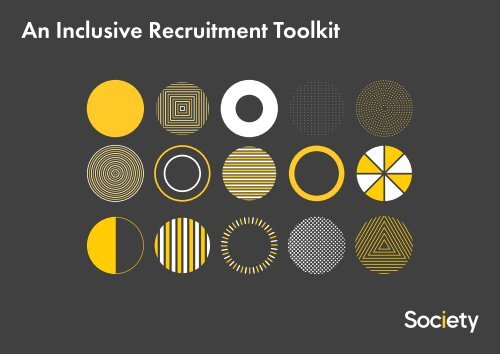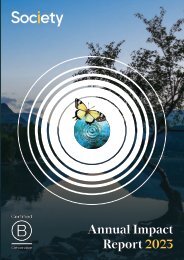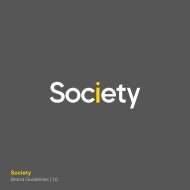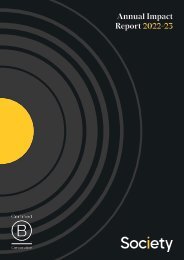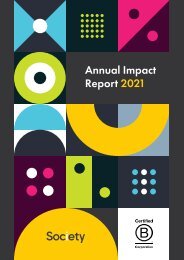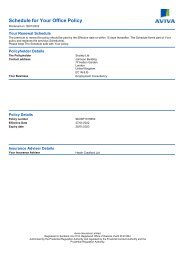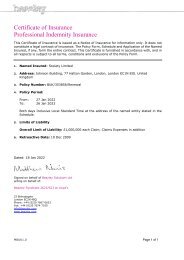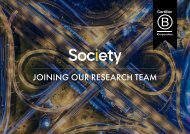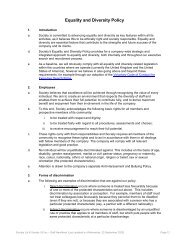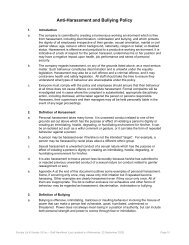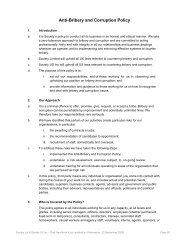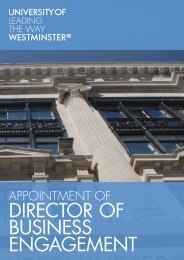An Inclusive Recruitment Toolkit
You also want an ePaper? Increase the reach of your titles
YUMPU automatically turns print PDFs into web optimized ePapers that Google loves.
<strong>An</strong> <strong>Inclusive</strong> <strong>Recruitment</strong> <strong>Toolkit</strong>
Introduction<br />
We have both an historic opportunity and a moral obligation to build more diverse,<br />
equitable, and inclusive workplaces. This much has been clear for some time. But there<br />
is a problem: progress to date has been far too slow. Decades of fine words and good<br />
intentions have failed to transform organisations in the way that the original champions of<br />
this agenda had hoped. That is particularly true at the senior executive and Board levels,<br />
which is where our company, Society, does most of its work.<br />
As a firm of headhunters, we have dedicated ourselves to driving positive change by<br />
helping our clients to attract, appoint and onboard more diverse and representative talent.<br />
In doing so, we have learned a bit about how to bridge the gap between good intentions<br />
and concrete results. We have now tried to distil that experience into this short document:<br />
a succinct compendium of practical actions that you can consider and challenge yourself<br />
with in order to refine and improve your recruitment approach. We have drawn the<br />
content from our own executive search practice and from extensive conversations<br />
with others committed to inclusive recruitment.<br />
We are making this document freely available with the hope of provoking meaningful<br />
change. Whether your organisation is a fresh convert to this agenda, or a longstanding<br />
champion of it, we challenge you to go through the ‘Practical Steps for Success’ below<br />
and to pick out some new actions that you might be able to embrace and implement.<br />
You can sign up to our quarterly newsletter for examples of this <strong>Toolkit</strong> in action. We<br />
also invite readers to contact us directly should they wish to discuss or debate any of the<br />
suggestions shared within<br />
Thank you for joining us in this vital and important work.<br />
This toolkit is not intended as a rigid prescription. We do not claim to have produced<br />
the final and definitive word on inclusive hiring. After all, this remains a rapidly evolving<br />
space, where constant vigilance and innovation is needed. But we recognise that<br />
organisations need practical, grounded ways of freeing their processes from arbitrary<br />
barriers, prejudices, and preferences. Because good intentions alone do not reliably<br />
deliver results.<br />
Nicole Arnold<br />
(nicole.arnold@society-search.com)<br />
Tanya Stevens<br />
(tanya.stevens@society-search.com)<br />
Conor Wilson<br />
(conor.wilson@society-search.com)<br />
3
Definitions<br />
So how might these concepts manifest<br />
within the workplace?<br />
Dimensions of Diversity<br />
•Gender<br />
Commonly Affected Groups<br />
Women<br />
•Ethnicity<br />
Ethnic minorities<br />
•Disability<br />
The disabled<br />
Equality is the state of being equal,<br />
particularly in terms of rights and opportunities.<br />
Equity is recognising each person’s various circumstances and<br />
distributing the resources and opportunities needed to reach an<br />
equal outcome.<br />
Diversity<br />
A range of different identities and lived<br />
experiences exists within your organisation<br />
(and each of its constituent teams/levels)<br />
•Sexuality<br />
•Age<br />
•Neurodiversity<br />
•Socio-economic<br />
LGBTQI people<br />
The young/the old<br />
The neurodiverse or autistic<br />
People who have experienced financial<br />
hardship<br />
•Personal circumstances<br />
Pregnant women, care givers, the married/<br />
unmarried<br />
•Faith<br />
Those with/without a specific religion or belief<br />
Diversity is a range of differences, including but not limited to<br />
race, ethnicity, gender, gender identity, sexual orientation, age,<br />
social class, disability, religious or political beliefs.<br />
Inclusion is the practice of providing equal access to<br />
opportunities and resources for groups of people that might<br />
otherwise be excluded or marginalized.<br />
Equity<br />
Structures and processes are<br />
continually reassessed to ensure<br />
that power, rights, access and<br />
opportunities are fairly distributed<br />
Inclusion<br />
Nobody is excluded or<br />
marginalised - every colleague can<br />
be confident that their thoughts,<br />
ideas, and perspectives will be<br />
valued and respected<br />
•Academic background<br />
•Historical prejudice<br />
Non-graduates<br />
People previously incarcerated, veterans<br />
Different acronyms are routinely bandied around these concepts - EDI, DEI, and even JEDI’ (the J is for ‘Justice’). There has<br />
been a recent pivot towards the ‘E’ in EDI focusing on ‘Equity’ rather than Equality, with companies such as Google now<br />
choosing to use this term when talking about their commitments.<br />
When an organisation possesses all of these attributes and commits to consistently working<br />
on them, it has successfully created the conditions where all people can truly thrive.<br />
3 5
The Business Case<br />
There is a moral case in favour of diversity: the belief that we have a responsibility to correct historic inequities in society.<br />
But we believe there is also a business case for diversity. There is extensive academic literature on this topic.<br />
The evidence points to several key advantages:<br />
Increased Creativity and Innovation<br />
Rocío Lorenzo[1] and her team surveyed 171<br />
companies to understand the link between<br />
diverse companies and innovation. They<br />
analysed innovation revenue (share of revenue<br />
being made from new products or services)<br />
against each company’s diversity statistics<br />
in terms of gender, ethnicity, age, etc. The<br />
data showed that companies with an aboveaverage<br />
level of diversity also reported an<br />
innovation revenue that was 19% higher than<br />
those with below-average levels of diversity.<br />
Better Decision Making<br />
The US software company Cloverpop[2]<br />
studied almost 600 business decisions made<br />
by 200 different business teams and found<br />
that those with the most diverse teams in terms<br />
of gender, geography, and age made better<br />
business decisions 87% of the time.<br />
Faster Problem Solving<br />
Harvard Business Review[3] found that teams<br />
with cognitive diversity solve problems faster.<br />
Cognitive diversity is defined as the inclusion<br />
of people who have unique perspectives and<br />
therefore process information or solve problems<br />
differently. In this study, researchers ran a<br />
strategic exercise with six teams and found<br />
that the teams with higher cognitive diversity<br />
all completed the challenge more quickly than<br />
those with less diversity, who either took longer<br />
or failed to complete it at all.<br />
Enhanced Ability to Design Products/<br />
Services That Reach Wider Markets<br />
Creating a diverse workplace leaves<br />
companies in a better position to meet the<br />
demands of a wider customer base. Harvard<br />
Business Review(4] found that firms with more<br />
diversity are 70% more likely to succeed in<br />
venturing into new markets than those who<br />
do not invest in recruiting talent from underrepresented<br />
groups.<br />
Higher Employee Engagement<br />
Sodexo conducts a major internal employee<br />
survey every two years.[5] They have found<br />
that greater diversity in their workforce –<br />
particularly in terms of gender balance<br />
– has played a key role in driving a 20%<br />
improvement in employee engagement over the<br />
past 20 years.<br />
Reduced Employee Turnover<br />
A report by Deloitte[6] shows that organisations<br />
that invest in recruiting, retaining and<br />
developing an inclusive and diverse workforce<br />
have 22% lower turnover rates than those<br />
without. Millennials in particular were 83%<br />
more likely to be engaged when they felt<br />
that their employer is committed to equality,<br />
diversity and inclusion.<br />
Better Company Reputation<br />
In a survey by PricewaterhouseCoopers[7],<br />
over 80% of its participants said that when<br />
deciding whether to work for an organisation<br />
or not, its policy and work on equality, diversity<br />
and inclusion played a major part in this<br />
decision.<br />
All of which Lead to Increased<br />
Profit and Impact<br />
McKinsey[8] reported in 2019 that the<br />
companies with the highest gender diversity on<br />
executive teams were 25 percent more likely<br />
to have above-average profitability than those<br />
with the least diversity, a figure which itself has<br />
increased from 2017 (21%) and in 2014 (15%).<br />
Additionally, organisations with “more than 30<br />
percent women executives were more likely to<br />
outperform companies where this percentage<br />
ranged from 10 to 30”.<br />
[1] How Diverse Leadership Teams Boost Innovation (2018)<br />
[2] Hacking Diversity with <strong>Inclusive</strong> Decision Making (2017)<br />
[3] Collaboration <strong>An</strong>d Teams: Teams Solve Problems Faster When They’re More Cognitively Diverse (2017)<br />
[4] How Diversity Can Drive Innovation (2013)<br />
[5] Sodexo: How Employee Engagement is Transforming the Catering Giant (2019)<br />
[6] <strong>Inclusive</strong> Mobility: How Mobilizing a Diverse Workforce Can Drive Business Performance (2018)<br />
[7] Magnet for talent: Managing diversity as a reputational risk and business opportunity (2017)<br />
[8] Diversity wins: How inclusion matters (2020)<br />
3 7
Establish Your EDI Commitment – Get Your House in Order!<br />
Define the Role - Do You Know What You Want?<br />
Campaign<br />
Development<br />
• Secure meaningful buy-in for your EDI strategy from the very top.<br />
• Identify your EDI successes and gaps - both within your<br />
organisation and through the impact of your work – and set<br />
concrete goals.<br />
• Make your commitments and values public and reflect them in your<br />
written and visual communications.<br />
• Champion and invest in the visibility and progression of existing<br />
colleagues from under-represented groups.<br />
• Talk to your team and canvass their opinions on your EDI successes<br />
and gaps, creating safe pathways for colleagues from underrepresented<br />
groups to share honest feedback.<br />
• Build up your diversity data and establish clear benchmarks<br />
against your industry, your customer base, and your wider<br />
community.<br />
• Keep the job description/person specification clear, sharp and<br />
focused. Be prepared to part ways with specifications that are too<br />
lengthy, or no longer fit for purpose.<br />
• Focus your person specification on skills, not on experience.<br />
• Recruit with openness to part-time, job-share and flexibly<br />
structured contracts.<br />
• Avoid time-based or unnecessarily restrictive requirements. eg.<br />
‘Must have at least ten years of senior management experience’.<br />
• Avoid vague and unquantifiable language like ‘culture fit’.<br />
• Remove degree requirements unless absolutely essential.<br />
• Develop a Candidate Pack that features relevant organisational,<br />
departmental and contextual feedback, as well as details about<br />
the assessment process.<br />
• Publish all the process dates, so that candidates can forward plan<br />
– this is particularly useful for those with caring responsibilities.<br />
• If you are open to providing development support for the<br />
appointed person, explicitly state this.<br />
• Consider gathering input and feedback on drafts of the Candidate<br />
Pack from stakeholders within the organisation, particularly<br />
colleagues from under-represented groups.<br />
• Consider translating the Candidate Pack into British Sign<br />
Language (BSL) clips and offering a Word version that is readable<br />
by assistive technologies such as screen readers.<br />
• Pick a sans serif font and clearly contrasting colours for all text.<br />
• Ensure you have thorough and regular training in place for all<br />
colleagues.<br />
3 9
Advertising<br />
Active Search<br />
Application Method<br />
Candidate<br />
Attraction<br />
• Include a clear salary range - doing so demonstrates your commitment<br />
to fair wage negotiations and transparently helps people decide on the<br />
financial viability of a role.<br />
• Pick inclusive job boards or social networks that are targeting specific<br />
under-represented groups and/or making demonstrable efforts to<br />
broaden their viewership.<br />
• Consider promoting the role through an independent consultant or<br />
prominent figure who can broaden your reach within particular underrepresented<br />
groups.<br />
• Think broadly about where you advertise. Consider options beyond the<br />
obvious trade press in your sector.<br />
• Team up with an executive search firm that will proactively build a talent<br />
pool that is more diverse and that can speak to candidates honestly and<br />
objectively about your EDI track record.<br />
• Ensure someone is available to field questions from the market in an<br />
informative and engaging way. This gives candidates an important first<br />
impression of your organisation and helps them to assess their fit.<br />
• Offer a freely accessible online ‘Open Hour’ where those thinking of<br />
applying can access the recruiting manager/team and ask questions.<br />
Consider different mediums such as Zoom or Instagram Live. Use this<br />
opportunity to showcase representation within your organisation.<br />
• Offer video relay services through organisations like SignVideo.<br />
• Do not ask candidates to provide details of their current salary. Judge<br />
them on their merits not their previous remuneration.<br />
• Know the rules of criminal record disclosure and commit to ‘Ban the Box’,<br />
a campaign that calls on employers to remove the criminal conviction<br />
tick-box from application forms.<br />
• Ditch the traditional covering letter approach and instead ask candidates<br />
to answer focused, role-relevant questions that test for capability and<br />
potential.<br />
• Recruit on a name-blind basis where any personal identifiers are<br />
removed from application material, or explore e-platforms that offer<br />
anonymised, randomised candidate assessment.<br />
• Include a meaningful diversity statement that goes beyond intent by truly<br />
reflecting how the campaign might address gaps in your current team.<br />
eg. ‘We are committed to appointing individuals from a wide range of<br />
backgrounds, lived experiences and cultures. We particularly encourage<br />
applications from communities under-represented in our organisation,<br />
including ethnically minoritized and disabled individuals.’<br />
• Communicate transparently to candidates about the process and their<br />
potential fit, and always offer and request feedback. This safeguards<br />
against negative effects on mental health that can accompany the<br />
logistically and emotionally draining process of applying for a job.<br />
• If you’re using pre-screening software or AI, regularly and rigorously<br />
audit it for bias.<br />
• Avoid reviewing applications until after the deadline date. In doing so,<br />
you will assess the full field holistically rather than risking favouritism<br />
towards those that apply early.<br />
• Film a short introductory video to give candidates a sense of the hiring<br />
manager, the team and role priorities.<br />
3 11
Ground Rules<br />
Selection Process<br />
Offers and Onboarding<br />
Assessment<br />
and Selection<br />
• Consider what ‘selection for potential’ looks like in your organisation.<br />
How do you recruit for growth/evolution versus outdated needs?<br />
• Over explain and pre-brief candidates about what will happen at every<br />
stage of the process, and give the rationale behind it. Summarise this<br />
through a short, written assessment brief.<br />
• Invite candidates to discuss their access needs without putting the onus<br />
on them to raise these first.<br />
• Be intentional and reflective when designing assessments. Challenge<br />
yourself to start from a blank sheet of paper rather than simply recycling<br />
what you have always done before.<br />
• Field a selection panel that has a mix of backgrounds, lived experience,<br />
and perspectives on the role. If you cannot easily find that mix, then bring<br />
in some panel members from outside your organisation.<br />
• Include a selection panel member whose role is to call out biases in post<br />
interview discussions, such as confirmation bias (interpreting information<br />
in a way that confirms or supports one’s prior beliefs or values) or halo/<br />
horns (where one trait, either good or bad, overshadows the rest).<br />
• Be cautious of decisions linked to ‘culture fit’. This can be code for affinity<br />
bias, the unconscious tendency to get along with others who are like you.<br />
• Do not hire someone solely because they possess an under-represented<br />
characteristic. Instead, ensure all candidates are fairly assessed against<br />
your agreed selection criteria.<br />
• Include a candidate-led ‘fact finding’ session that gives candidates the<br />
opportunity ask questions and to develop a sense of what it is like to<br />
work at your organisation.<br />
• Include a ‘workshop’ session, where candidates discuss a live issue with<br />
colleagues and test collaboration in action through a real-life scenario.<br />
• Allow candidates to present interview tasks through their preferred<br />
medium.<br />
• Develop interview questions that test for capability and potential versus<br />
an over-reliance on historic questions linked to past performance.<br />
• Share interview questions/themes in advance, or give candidates some<br />
reflection time on the questions/themes directly ahead of their interview.<br />
• Build in time for candidates to ask questions to you.<br />
• Ask candidates for feedback on their assessment experience.<br />
• Offer the advertised salary (ie. what the job is worth), not what the<br />
person is already being paid plus a little bit extra. If you do not, you risk<br />
simply perpetuating existing income equalities that particularly affect<br />
women and minority groups.<br />
• Offer the successful candidate the opportunity to take references on the<br />
recruiting manager.<br />
• Formalise agreements in clear, concise language that all parties can<br />
understand. New employees should not need to hire a lawyer to<br />
understand your employment contracts.<br />
• Develop a clear on-boarding plan.<br />
3 13
About Society and Note of Thanks<br />
Society is a global executive search firm and certified B Corporation committed<br />
to open, inclusive recruitment. With colleagues in the United Kingdom, the<br />
United States, and New Zealand, we solve senior hiring challenges for<br />
responsible businesses and purpose-driven organisations around the world. We<br />
believe that we can bring about positive change by placing exceptional people<br />
into meaningful roles within good organisations.<br />
www.society-search.com<br />
We consulted a number of individuals when developing this toolkit, and are<br />
particularly grateful to the following people for their input, ideas, challenge, and<br />
contributions: Rohati Chapman, Tom Crawford, Nicola Davies, Lois Donegal,<br />
Tigho Feldman, Jan Gooding, Dee Jas, Hashi Mohamed, Mahua Nandi and<br />
James Watson O’Neill.


